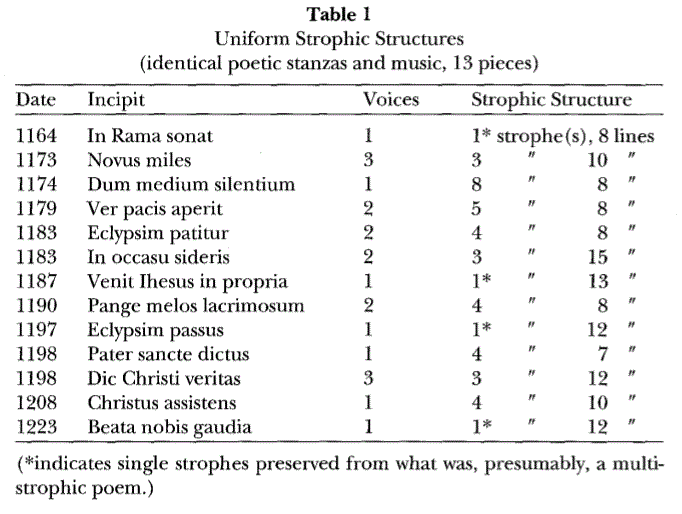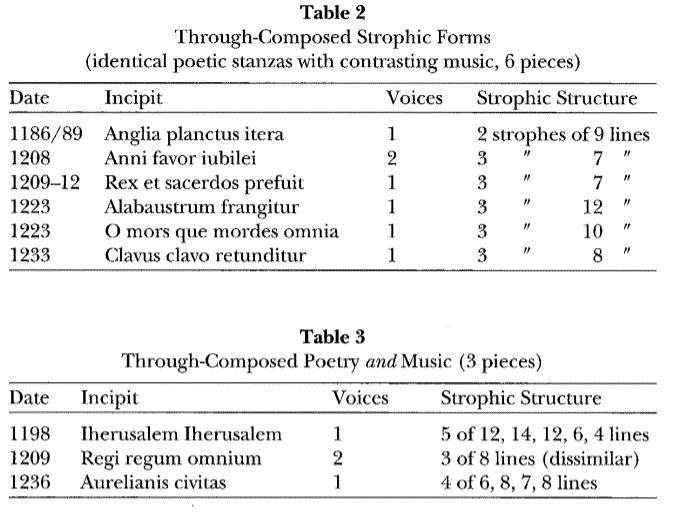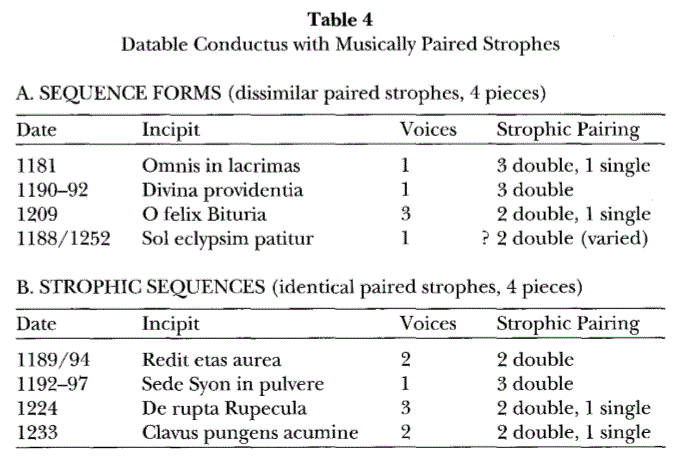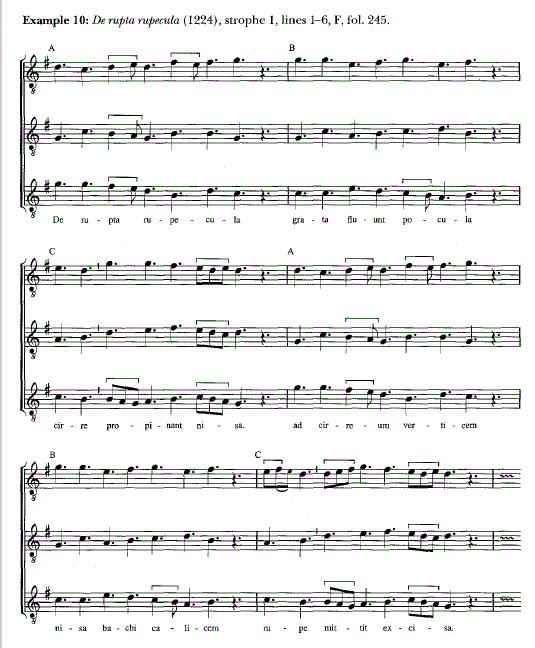|
��Datable "Notre Dame" Conductus: New
Historical Observations on Style and
Technique�Q
Stanzaic Construction
�@In terms of large-scale designs, the music and poetry
of the datable conductus collaborate to provide four different and
representative types of strophic organization. Each of the arrangements
depends on the balance of repetition between music and text. The four
types include: 1) regular strophic forms, where the same recurring
block of music is repeated to accompany a series of identically formulated
text stanzas; 2) through�]composed strophic designs, where
identical poetic stanzas are answered with music that does not mirror
their matching forms; 3) strictly through�]composed pieces with no
repetition of larger formal units on either textual or musical levels; and
4) works that recall a structural feature especially reminiscent of the
liturgical sequence or the vernacular lai, in which textual
strophes are disposed into a series of pairs, and where each double-stanza
unit is differentiated by a contrasting musical setting.
�@��K�̓f�U�C���ł����Adatable conductus�̉��y�Ǝ��́A�l�̈قȂ��������đ�\�I�ȗL�ߍ\�����������邽�߂ɋ������Ă���B���ꂼ��̍����́A���y�ƃe�L�X�g�̊Ԃ̌J��Ԃ��o�����X�Ɉˑ����Ă���B�S�̃^�C�v�͈ȉ��̂��Ƃ��ł���B
1)�K���I�L�ߌ`���B�����`�ʼn��x���o�����鉹�y�I�u���b�N���A����̌`�������ꂽ�e�L�X�g�̃X�^���U�̘A�������Ƃɂ��A�J��Ԃ����B
2) �ʍ�I�L�߃f�U�C�� �B�����ł͓���̎��I�X�^���U������ɍ����`���f�����邱���Ȃ����y�ɉ�������B
3) �����ɒʍ�I�ɍ�Ȃ��ꂽ��i�B�e�L�X�g�I�ɂ����y�I�ɂ������̌`���P�ʂ̌J��Ԃ��������Ȃ��B
�S�j�V���I�ȃZ�N�G���c�B�A�␢���I�h���[�h�̖��c��̓������������B�e�L�X�g�̎���́A��A�̃y�A�ƂȂ�A���ꂼ��̈�g�Ẩ��ߒP�ʂ́A�Δ�I�ȉ��y��������
�@Of
the four poetic schemes, the most common is the regular strophic form.11
The repertory under scrutiny includes thirteen works disposed in this
manner (see table 1).12 Included in this table are four pieces that
survive only as single strophes, but that presumably were originally
multistanzaic.13 The organization of Latin lyric poetry into repeating
strophes appears prominently in the medieval West as early as the fourth
century in the poems attributed to St. Ambrose (reg. 370-397), the bishop
of Milan who is credited with first popularizing the Latin hymn and
securing its entry into the liturgy of the Western church. The continued
significance of the strophic form is attested by its predominance not only
in medieval Latin lyric, but also in the vernacular songs of troubadours,
trouveres, Minnesanger, and of Spanish, Italian, and English poets. By the
late twelfth century, during the activity of the earliest composers and
poets that can be associated with the Parisian conductus, the strophic
model was a means of arranging poetry and song that already possessed a
long history, widespread esteem, and the stamp of liturgical approbation.
1)�K���I�L�ߌ`��
�@�S�̎��̕��ނɂ����āA�����Ƃ���ʓI�Ȃ̂́A �K���I�L�ߌ`���i��L�@�j�ł���B�����������p�[�g���[��13��i�ł���B�iTable1�Q�Ɓj�B����table�ł́A��̎��債�����݂��Ȃ���i���S���邪�A�����炭�͂��Ƃ��Ƃ́A�����̉��߂����������̂Ǝv����B�J��Ԃ�����������e����̝R��̍\���́A�ŏ��̗L���ȃ��e����^�̂����A��������̋V���ɂ���������ꂽ�~���m�̎i�����A���u���V�E�X�̂��̂Ƃ���Ă���4���I�O���̒������E�̎��Ɍ����ɂ݂���B�����̎���\���̏d�v���́A�������e����̝R������łȂ��Atroubadours, trouveres�AMinnesanger, �X�y�C����A�C�^���A��̉́A�p��̎�,�̐����̂ɂ����Ă��F�߂���悤�ɂȂ����B12���I�㔼�܂łɁA�����Ƃ������̍�ȉƁA���l�̍s���i�p������conductus�Ɋ֘A�����j�ɂ����āA���僂�f���͎��Ɖ̂̃A�����W�̎�i�ƂȂ��Ă����B����͂��łɁA�������j�A�g�債���]���A�����ċV���I�^���Ă����̂ł���B
 �@ �@
�@Other
than their shared structures, though, there appears little else to tie
these thirteen datable works to each other, nor is their use of a regular
strophic arrangement particularly indicative of any general tendencies in
the Notre Dame conductus repertory. Polyphonic and monophonic compositions
are nearly equally represented (6 and 7 works, respectively), and as table
1 demonstrates there is no overwhelming preference for either a specific
number of lines per stanza or a particular number of strophes per song.
The chronological boundaries of the datable strophic conductus are also
quite extensive. The examples stretch from the earliest piece in the
corpus, In Rama son at gemitus, from the 1160s, to Philip the
Chancellor's Beata nobis gaudia of 1223. Hence, any attempt to evaluate a strophic Notre Dame
conductus for the purpose of determining its time of
composition must rely on other stylistic
attributes.
�@�V�F�A�����\���ȊO�ɂ������A�����P�R��datable��i�݂͌��ɑ��ɂ͌��т����Ƃ͂Ȃ��A�m�[�g���_���y�h��conductus�̃��p�[�g���[�ɂ������ʓI�X������Ɏw�������悤�ȋK���I�ȗL�ߓI�z����g���Ă���킯�ł��Ȃ��B�|���t�H�j�b�N���邢�̓��m�t�H�j�b�N�ȍ�i�͂قƂ�Ǔ�����������i���ꂼ��U�C�V���x�j�A������table�P�ɂ���悤�ɁA�X�^���U������̍s�̐���̓�����̐߂̐��̑I�D���悤�Ȃ��Ƃ��Ȃ��Bdatable�ȗL�ߍ\��������conductus�̎��n��I���E�́A�܂����Ɋg������Ă���B�ŏ�������̂��������L�W��́A1160�N���In
Rama son at gemitus����1223�N��Philip the Chancellor'�� Beata nobis
gaudia�܂łł���B����Ȍ�A ���̍�ȔN�㌈��̂��߂ɁA�m�[�g���_���y�h��conductus��]�����邽�߂̎��݂́A���̗l�������ɗ��炴��Ȃ��Ȃ����̂ł���B
�@Nonetheless,
even though the presence of regular strophic works in the Notre Dame
repertory extends at least over a half century, it appears significant
that eleven of the thirteen datable examples were written prior to the
turn of the century. In the wake of pivotal musical advancements,
noticeable for the first time around the year 1200 and associated with the
figure of Perotinus,14 it is not unreasonable to conjecture that in the
early decades of the thirteenth century a uniformly strophic musical setting of a�@conductus
poem may have been viewed as a piece of
restrained, if not conservative, compositional workmanship.
�@�ɂ�������炸�A�m�[�g���_���y�h�̃��p�[�g���[�ɂ����āA���Ƃ��K���I�L�ߍ�i�̑��݂����Ȃ��Ƃ������I���Ċg�債���Ƃ��Ă��A�P�R��datable��̂����P�P�͐��I�̕ς��ڈȑO�ɏ����ꂽ���̂ł��邱�Ƃ͑厖�ł��낤�B�d�v�ȉ��y�̐i���̌��ʂƂ��āA1200�N���ɏ��߂Ē��ڂ��W�߁A�����ăy���^���̍�i�Ɋ֘A���āA13���I�����̐��\�N�ԁAconductus�̎��ɂ��ē��ꂵ���߂̉��y�ݒ�́A��ȏ�̎d�オ���}������i�Ƃ��Č����邩������Ȃ��Ɛ��_���邱�Ƃ͕s�\�Ȃ��Ƃł͂Ȃ����낤�B
2) �ʍ�I�L�߃f�U�C���A3) �����ɒʍ�I�ɍ�Ȃ��ꂽ��i
�@This
hypothesis may even be substantiated by considering the datable poems
whose individual strophes are poetically identical, but which feature
different musical settings for each stanza (see table 2). In contrast to
the regular strophic conductus that reuses its music, through-composed
settings of strophic poetry appear to be a slightly later phenomenon. The
first appearance of such a work in the repertory does not occur until
after 1185, and the remaining five examples all issue from the thirteenth
century.
�@���̉����i13���I�����̐��\�N�ԁAconductus�̎��ɂ��ē��ꂵ���߂̉��y�ݒ�́A��ȏ�̎d�オ���}������i�Ƃ��Č����邩������Ȃ��Ɛ��_���邱�Ɓj�́Adatable�Ȏ����l������Ƃ͂�����Ƃ��Ă���B���̌X�̐߂͎��Ƃ���identical�ł��邪�A���ꂼ��̃X�^���U�ւ̈قȂ������y�ݒ肪�Ȃ���Ă���Ƃ�������������B�itable2�Q�Ɓj�B
�K���I�L�ߓIconductus�i���y���ė��p����Ă���j�Ɣ�r����ƁA�L�ߎ��̒ʍ�I��Ȑݒ�͎����̌��ۂł���悤�Ɏv����B13���I�̃��p�[�g���[�ɂ����邱��������i�̂����̍ŏ��̏o���́A1185�N�ɏ��߂Č����邪�A�c���5�̗�͂��ׂ�13���I����̂��̂ł���B

�@The same scenario also seems to hold true, if not to
an even greater extent, for conductus that feature not only
through-composed music but texts as well. In these compositions there is
no hint either of musical or poetic repetition on the strophic level. Such
wholly through-composed works do not surface until nearly a decade after
the earliest strophic conductus with through-composed music in table 2.
Although they constitute a very small number of datable works, they appear
to represent an even later departure (see table
3).
�@���������̋K�͂�����قǑ傫���Ȃ��ꍇ�A�ʍ쉹�y����ł͂Ȃ��A�e�L�X�g�����l�̓���������conductus�ɑ��Ă��A�����V�i���I���������Ă���悤�Ɏv����B���������Ȃɂ����ẮA���y�I�ɂ����I�ɂ��L�߃��x���ł̌J��Ԃ����Ȃ��B���������S�̓I�Ȓʍ쉹�y��i�́A�����Ƃ������̗L�ߓIconductus��table�Q�ɂ�����ʍ쉹�y�ƂȂ������10�N�Ԓ��x�́A�قƂ�Ǖ\�ʉ����Ă��Ȃ�(see
table 3)�B
�@Although it is
readily apparent that conductus
set to strophic poetry were cultivated
throughout the Notre Dame era, the above tabulations suggest that during
the decade prior to the turn of the century �@the artists associated with the Paris cathedral
began more customarily to fashion their
music-and eventually their poetry as well-outside the constraints of the
strophic models that most closely characterize earlier medieval Latin
lyric poetry and the vernacular songs of the troubadours and trouveres.
�@�L�ߎ��Ƃ��č��ꂽconductus���m�[�g���_�����シ�ׂĂɂ킽���ĊJ�ꂽ���Ƃ͖��炩�ł���B��L�\�́A���I�̕ς��ڂɐ旧�P�O�N�قǂ̊ԁA�p���̃J�e�h�����ƌ��т��Ă����|�p�Ƃ������A���������̃��e����̝R���
troubadours��trouveres�̐����̂𖧐ڂɓ����Â������僂�f���̐���̊O�ŁA�ނ�̉��y�������ċ��ɓI�ɂ͓��l�ɔނ�̎��������s�����悤�Ƃ������Ƃ������Ă���B
�S�j�V���I�ȃZ�N�G���c�B�A�␢���I�h���[�h�̖��c��̓�����������
�@Just
as the strophic conductus relied on an older scheme, so does the fourth
and final poetic design in the datable repertory, which involves the
organization of textual strophes into series of musically identical pairs.
This procedure has an especially obvious precedent in the double versicles
of the sequence, a form of great antiquity that was especially prized at
Paris.15
�@�L��conductus�����Â��X�L�[���ɗ����Ă���悤�ɁA4�Ԃ߂́A�����čŌ�ł�����A���y�I�ɓ���Ȉ�A�̃y�A�ɂ�����e�L�X�g�̎���̍\�����܂�ł���datable
���p�[�g���[�ɂ����鎍�̃f�U�C�������l�ɂ���ɗ����Ă����B���̉ߒ��́A�Z�N�G���c�B�A��double
versicles�ɖ��炩�ɐ旧���Ă���B���̔��ɌÕ��Ȍ`�̓p���ɂ����ďd���Ă������̂ł���B
�@One of the most celebrated Notre Dame poet-composers, the cantor Adam
(who until recently bore the name of the abbey of Saint Victor, where he
spent his final days) is credited as the prime mover in the regularization
and cultivation of the poetic and musical form of the sequence.16 The evolution
of the sequence into the form now associated with Adam of Paris owes much
to the same aesthetics that shaped the lyric poetry of the conductus.17
Although the Latin sequence had originated in the ninth century as a genre
that typically featured texts either in prose or in quantitative verse,
by the eleventh it had begun to emulate the new rhymed, rhythmic lyric
based on syllable count and the location of the final accented syllable
in the poetic line. In the course of the next hundred years, significant
developments that were to affect sequence texts included the casting of
its paired versicles into stanzas that are often quite similar both in
length and form to conductus strophes, and ultimately encompassed the fashioning
of all the versicle pairs to match each other in structure and length.
�@�m�[�g���_���y�h�̍�ȉƂ̂����ł����Ƃ��̎^����Ă�����ȉƂ�1�l�ł�����Adam�i�ȑO��Adam
de St.Victor�ƌĂ�Ă����j�́A�Z�N�G���c�B�A�̎��Ɖ��y�`���̐������ƊJ��̑��l�҂Ƃ��ĔF�߂��Ă����BAdam
of Paris�Ɋ֘A�����Z�N�G���c�B�A�̌`�Ƃ��Ă̐i���́Aconductus�̝R����`�������̂Ɠ������w�ɕ����Ă���B���e����̃Z�N�G���c�B�A�́A�U�����ʎ��ɂ���������I�ȉ̎���������Ƃ��āA9���I�ɔ����������A11���I�܂łɂ���́A�V���u�����Ǝ��̍s�ɂ����čŌ�ɃA�N�Z���g�̂���V���u���̈ʒu���x�[�X�Ƃ����V�����R��ɕ키�悤�ɂȂ����B����100�N�ԂɋN�����d��Ȕ��W�́Apaired
versicles�i�����ƌ`�ɂ�����conductus�̐߂Ɠ����ł���A���ɓI�ɂ͂��̂��̂̍\���ƒ����ɍ�����versicle
pair�̂��ׂĂ̗��s���܂�ł����j�̃X�^���U�ւ̓��˂ł������B
�@At least
seven "sequence-form" conductus occur within the datable repertory (see
table 4). Included as a possible eighth case in this tally is the
planctus Sol eclypsim patitur (1188 or, more probably, 1252), whose
four preserved strophes frequently display some striking parallelisms
suggesting that it may actually exhibit a free form of strophic pairing.
Such a practice of varied doubling has been associated with the repertory
of versus from Aquitania in Southern France, and would be fitting for this
composition, which appears to emanate from Spain.18
�@���Ȃ��Ƃ��V�̃Z�N�G���c�B�A�`����conductus���Adatable ���p�[�g���[�Ɍ����(see
table 4)�B���̏W�v�ɂ����ĂW�Ԗڂ̃P�[�X�Ɋ܂܂��̂��Aplanctus�ilament;�Z�N�G���c�B�A�̈��)Sol eclypsim
patitur�ł���B���̂S�̐߂́A�����Ό�����parallelism�������B����͎��ۂ́A�A�L�߃y�A�̎��R�Ȍ`����������������Ȃ��B�����������܂��܂ȓ�d���̎��H�́A��t�����X�̃A�L�e�[�k��versus�̃��p�[�g���[�ƊW���Ă���A�X�y�C�����甭����ꂽ�Ǝv���邱�̍�i�ɂ͍����Ă����悤�ł������B

�@ As table 4
demonstrates, datable examples of conductus poetry in sequence form
illustrate two different types of verse structures. Each pair of strophes
may either be distinct from the others in its poetic scheme, or,
alternately, every one of the doubled stanzas may match the others in the
length, number, and accentual patterns of its lines. In other words, the
texts alone of the latter category are indistinguishable from regular
strophic conductus, and the disposition of such works into sequence form
is evident only through the presence of music that offers a different
setting for every other stanza. This latter scheme is known as the
strophic sequence, to borrow a term used by Hans Spanke (1936: 76-77).
�@Table4�������悤�ɁA�Z�N�G���c�B�A�`����conductus����datable�ȗ�́Averse�\���̈قȂ�Q�̃^�C�v�������Ă���B�X�^���U�̂��ꂼ��̃y�A�͂��̎��̃X�L�[���ɂ����Č݂��ɋ�ʂ����B���邢�͌��݂ɁA��d�X�^���U�̂��ꂼ��͂��̒����A���A�s�̃A�N�Z���g�p�^�[���ɂ����ă}�b�`���Ă���B����������A��҂̃J�e�S���[�̃e�L�X�g�݂̂ł́A�K���I�L��conductus����͋�ʂ��ł��Ȃ��̂ł���B�����āA�Z�N�G���c�B�A�`���̂���������i�̐����́A���ꂼ��̑��̃X�^���U�ɑ��ĈقȂ����Z�b�e�B���O�����Ă��鉹�y�̑��݁i���\�`�@sequence
form)��ʂ��Ă̂ݖ��炩�ɂȂ�B���̌�҂̃X�L�[���́A�L�� sequence�Ƃ��Ēm���Ă���B

�@The enumeration of these two classes in table 4 shows
that, just as with the through-composed strophic structures discussed
above, both types of sequence-form pieces are absent from the earliest
layer of datable Notre Dame compositions. Datable conductus with paired
strophes do not surface until 1181, as much as ten to fifteen years after
the earliest known examples in the main sources. Strophic sequences in
particular appear to be a later development.
�@table 4�ɂ���悤�Ȃ��������ӂ��̃N���X�ւ�sequentia�`���̐U�蕪���́A�Z�N�G���c�B�A�`���̍�i�̗��^�C�v���A
�ʍ�L�ߍ\���̂悤�ɂ͍ŏ�����datable�m�[�g���_����i���ɂ͌���Ȃ����Ƃ������Ă���B�y�A�ƂȂ�������̂���datable
conductus��1181�N�ɏ��߂ĕ\�ʉ������B��Ȏ����̒��ōł������ɒm���Ă����Ⴉ��10�N����15�N��̂��Ƃł���B�L��sequences�́A����ɓ��ɔ��W���邱�ƂɂȂ��B
�@The first datable
instance of such a work (�qedit etas aurea of 1189 or 1194)
postdates the earliest member of the "nonstrophic" type by at least eight
years (Omnis in lacrimas from 1181). The apparently later arrival in the
conductus repertory of the strophic sequence, in which all stanzas are essentially equal in
construction, consequently mirrors the shift of
the liturgical sequence itself towards an increasingly homogenized poetic
structure.
�@�ŏ���datable�ȗ�� (�qedit etas
aurea of 1189 or 1194)�ł��邪�A����͐߂̂Ȃ��^�C�v�̍ŏ����̂��� Omnis in lacrimas from 1181�������Ȃ��Ƃ�8�N�Ԃ͒x��Ă���B ���ׂẴX�^���U���{���I�ɓ������L��sequence��conductus���p�[�g���[�Ƃ��Ă̖��炩�ɒx�������́A���̌��ʁA�T��I�Z�N�G���c�B�A�i���ꎩ�g���ψꉻ���ꂽ���I�\���Ɍ������Ă����j�̕ύX���f�����ƂɂȂ����̂ł����B
�@The
examination of large-scale textual and musical designs in the datable
works thus shows some rather contradictory trends between the uniform and
through-composed strophic conductus on the one hand and those compositions
that feature paired versicles on the other.
�@datable�ȍ�i�Q�̑�K�͂ȃe�L�X�g�I���y�I�f�U�C���̒����͂���䂦�ɁA����ɂ����ẮA����E�ʍ�I�L�ߓIconductus�ƁA�����ɂ����Ă� paired versicle�̓�����������i�Q�Ƃ̊ԂŁA�������̖��������X���������B
�@As the datable
repertory proceeds chronologically, a decline in the number of pieces
with regular strophic
organization on both poetic and musical levels
is noticeable. Only two of the conductus based on this model were written
after the turn of the century.l9 In contrast, datable works with strophic
texts set to through-composed music increase after 1200, with the first
example appearing in Anglia planctus itera, placed either in 1186
or 1189.
�@datable���p�[�g���[�����n��ɐi��ł����ɏ]���A���Ɖ��y���x���ɂ�����K���I�ȗL�ߍ\��������i���̌����͒��ڂ��ׂ��ł���B���������K���I�ȗL�ߍ\�������f���Ƃ���conductus�̂����̓�́A���I�̕ς��ڌ�ɏ�����Ă����B�ΏƓI�ɁA�L�߃e�L�X�g�����ʍ쉹�y�Ƃ��Đݒ肳�ꂽdatable�ȍ�i�́A1200�N��̑������Ă���B�ŏ��̗�́A1186�N���邢��1189�N�ɍ��ꂽAnglia
planctus
itera�ɔF�߂���B
�@The most recent practice of all, however, arose with settings that are
through-composed both musically and poetically, in which the design of
the lyrics as well as the music is free from the successive repetition
associated with stanzaic designs. These "thoroughly composed"
pieces surface at least by 1198 with the example of the planctus Iherusalem Iherusalem and remain to include one of the very latest of the datable Parisian conductus, Aurelianis civitas, from 1236.
�@�������A���ׂĂ̂��������ԐV�������H�́A���y�Ǝ��̗����Œʍ삳�ꂽ�ݒ�ƂƂ��ɏo������B���̝R��̃f�U�C���́A���y���l�A�X�^���U�̃f�U�C���ɔ����J��Ԃ��\���Ƃ͖��W�ł���B���������ʍ��i�́A���Ȃ��Ƃ�1198�N�܂łɂ�planctus
Iherusalem
Iherusalem�ƂƂ��ɕ\�ʉ�����B�����āA1236�N�́A�����Ƃ��V����datable�ȃp������conductus
�̈��Aurelianis civitas���₳��Ă���B
�@On the other hand, an opposite trend is visible in the texts of those
pieces that employ the doubled strophic pairing typically associated with
the liturgical sequence. In these works, which first occur in the datable
repertory by 1181, the greatest variety in poetic scheme occurs in the
earlier compositions, while the stricter textual regularity of the strophic
sequence appears later (by 1189 or 1194) and prevails longer (up to at�@least
1233).
�@�����A�T��I�Z�N�G���c�B�A�Ɗ֘A������d�L�� pairing�������i���̃e�L�X�g�ɂ����ẮA���̌X�������Ď���B1181�N�܂łɍŏ���datable���p�[�g���[�ƂȂ�������������i�ɂ����āA�����Ƃ��傫�Ȏ��̃X�L�[���̕ω��́A��菉���̍�i�ɂ����ďo�����A��茵�i�ȗL��sequence�̃e�L�X�g��̋K�����͌�ɏo���i1189�N���邢�͂P�P�X�S�N�j���A��蒷�����z�����B�i���Ȃ��Ƃ�1233�N�܂Łj
|
 �@
�@

